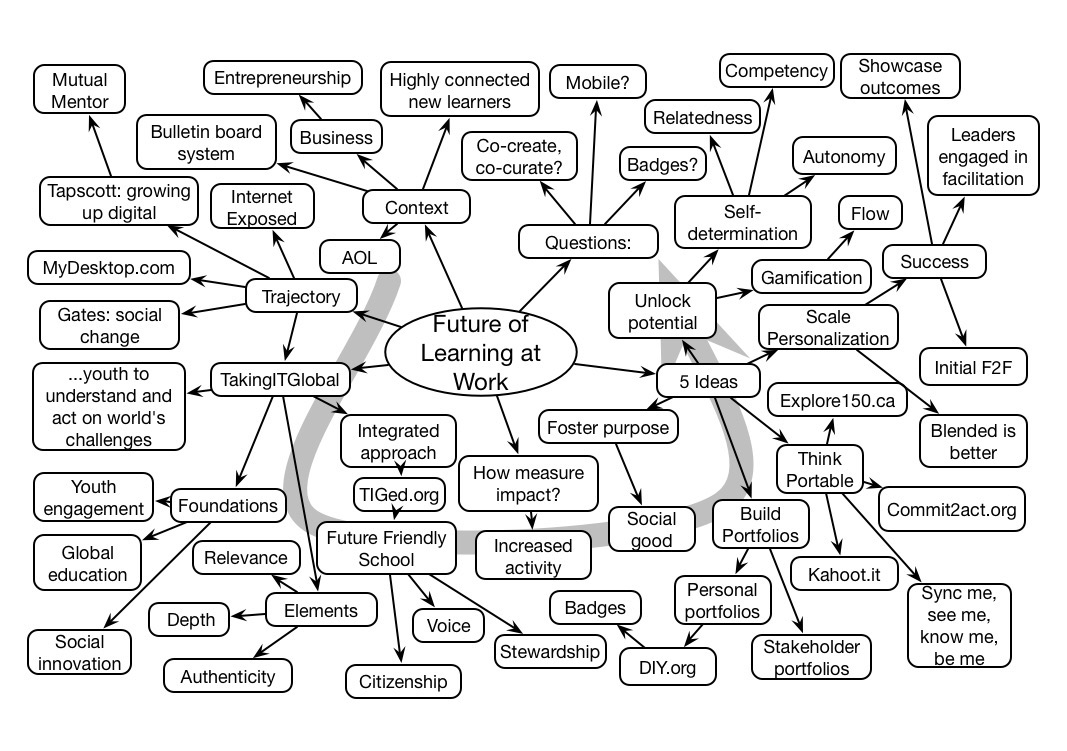Adam Savage gave a thoughtful, entertaining, and ultimately moving talk about how Art and Science are complementary components of what makes us human. He continued telling stories that kept us laughing while learning, and ended on a fabulous note about being willing to be vulnerable as a person and a parent. Truly a great keynote.
Search Results for: mindmap
Connie Yowell #DevLearn Keynote Mindmap
David Pogue #DevLearn Keynote Mindmap
David Pogue addressed the DevLearn audience on Learning Disruption. In a very funny and insightful presentation, he ranged from the Internet of Things, thru disintermediation and wearables, pointing out disruptive trends. He concluded by talking about the new generation and the need to keep trying new things. 
David McCandless #CALDC3 Keynote Mindmap
Juliette LaMontagne #LSCon Keynote Mindmap
Juliette LaMontagne closed the Learning Solutions conference with the compelling story of the Breaker project, connecting kids to real world experiences.

Michael Furdyk #LSCon Keynote Mindmap
Michael Furdyk gave an inspiring talk this morning about his trajectory through technology and then five ideas that he thought were important elements in the success of the initiatives he had undertaken. He gave lots of examples and closed with interesting questions about how we might engage learners through badges, mobile, and co-creation.

Tom Wujec #LSCon Keynote Mindmap
Tom Wujec gave a discursive and well illustrated talk about how changes in technology were changing industry, ultimately homing in on creativity. Despite a misstep mentioning Kolb’s invalid learning styles instrument, it was entertaining and intriguing.

Agile Bay Area #LNDMeetup Mindmap
I’ve been interested in process, so I attended this month’s Bay Area Learning Design Meetup that showcased LinkedIn’s work on Agile using Scrum for learning design. It was very nice of them to share the specifics of their process, and while there were more details than time permitted to cover, it was a great beginning to understand the differences.
Basically, a backlog is kept of potential new projects. They’re prioritized and a subset is chosen as the basis of the sprint and put on the board. Then for two weeks they work on hitting the elements on the board, with a daily standup meeting to present where they’re at and synchronize. At the end they demo to the stakeholders and reflect. As part of the reflection, they’re supposed to change something for the next iteration.
There’re different roles: a project owner who’s the ‘client’ in a sense (and a relation to who may be the end client). There is a Scrum master who’s responsible for facilitating the group through the steps, and then the team, which should be small but at least represent all the necessary roles to execute whatever is being accomplished.
When I asked about scope, they said that they’ve found they can do about 100 story points (which are empirical) in a sprint, and they may distribute that across some elearning, some job aids, whatever. They didn’t seem too eager to try to quantify that relative to other known metrics, and I understand it’s hard, particularly in the time they had. Here’s the Mindmap:
Allen Interactions also discussed their SAM project (which I know and like), but the mind map didn’t match too well to their usual diagram (only briefly shown at the end), and I ran out of time trying to remedy. It’s better just to look at the diagram ;).





